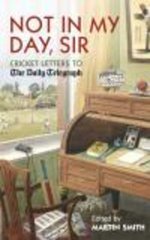Not In My Day, Sir
Martin Chandler |Published: 2011
Pages: 245
Author: Smith, Martin (Editor)
Publisher: Aurum
Rating: 3.5 stars

Not In My Day, Sir is a collection of cricketing letters that have been published over the years in that bastion of conservatism, the Daily Telegraph. Most of the letters are short and pithy, and few exceed 500 words, although in a number of cases that is no doubt rather more down to the zeal of the original editor than the efforts of the author of the epistle. The important point however is that there is no wastage here, and no writer is allowed to ramble unnecessarily.
The letters appear in strict chronological order, a format which has an obvious logic to it, although it may have worked better if they had been grouped by subject, coupled with an index and perhaps, certainly in the case of the better known letter writers, an index of those names as well.
Changes in the style of written English mean it is not always easy to see, generations later, whether certain correspondents wrote their missives with tongue in cheek or not, particularly those with the most vivid imaginations. Pre-war letters contained some curious proposals, seemingly in all seriousness, for improving the game as a spectacle. One such suggested that any batsman who failed to score thirty runs in an hour should be timed out, which brought howls of derision from another reader who clearly took it at face value. Another expressed the view that the teams should take it in turns to bat after each interval, thus having two innings running, effectively, at the same time. A third that particularly caught my eye was a suggestion that golf ball manufacturers be called upon to manufacture dimpled cricket balls, with an analysis of what that would achieve.
Moving on to more grave and weighty matters I had hoped that the correspondence in 1933 and 1934 about Bodyline might be illuminating, although in fact it was relatively disappointing, albeit highlighting the fact that the average Englishman was at a huge disadvantage in commenting meaningfully for want of actually having seen any of the play. Much more rewarding were the letters evidencing attitudes to South Africa during the D’Oliveira Affair as that unfolded through 1968 and 1969.
Besides the stereotypical academics, clergymen, lawyers and retired Colonels the Telegraph has also had more than its fair share of “celebrity” correspondents. There is a wonderful letter from Sir Alec Bedser from 2006 reacting to Simon Hughes describing him as a “dobber”, and a similar offering from Ted Dexter by way of reaction to a piece about helmets. It is at this point that an occasionally irritating feature of the book must be pointed out, that being a reader’s inability to fully understand some of the letters by virtue of the fact that the article which prompted their being written is not reproduced nor even summarised. It would certainly have helped with the Bedser and Dexter letters, particularly the latter, and also in relation to some interesting letters from 1985, including one from EW Swanton, responding to an article about Bodyline that had been prompted by the Australian television series that had recently been transmitted.
Although I did not embark on Not In My Day, Sir with any great expectations, I actually found it to be very entertaining. Whatever minor criticisms I have made of the editing Martin Smith has managed to choose a fascinating and eclectic selection of correspondence which, by its nature, is easy to dip in and out of and does not demand much in the way of intellectual committment from its reader. Not essential reading by any means, but certainly recommended.






Leave a comment